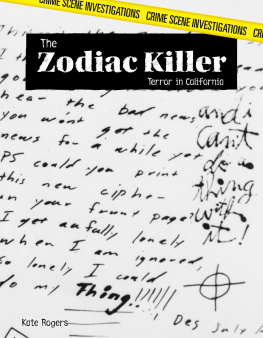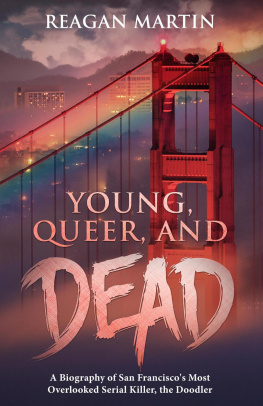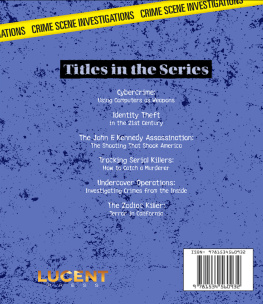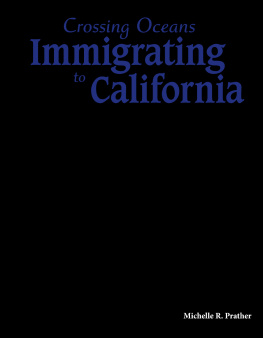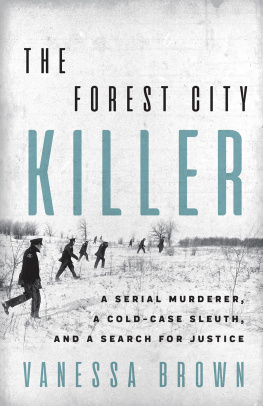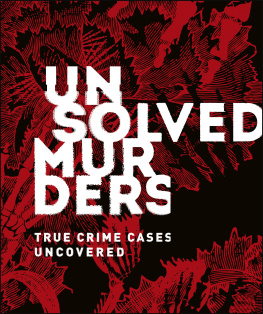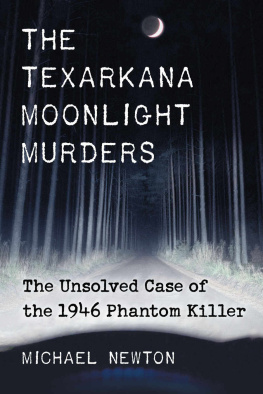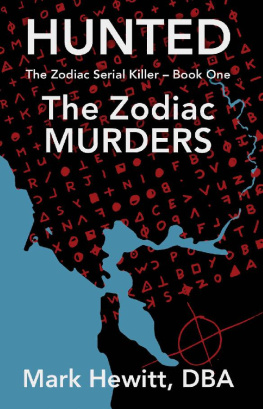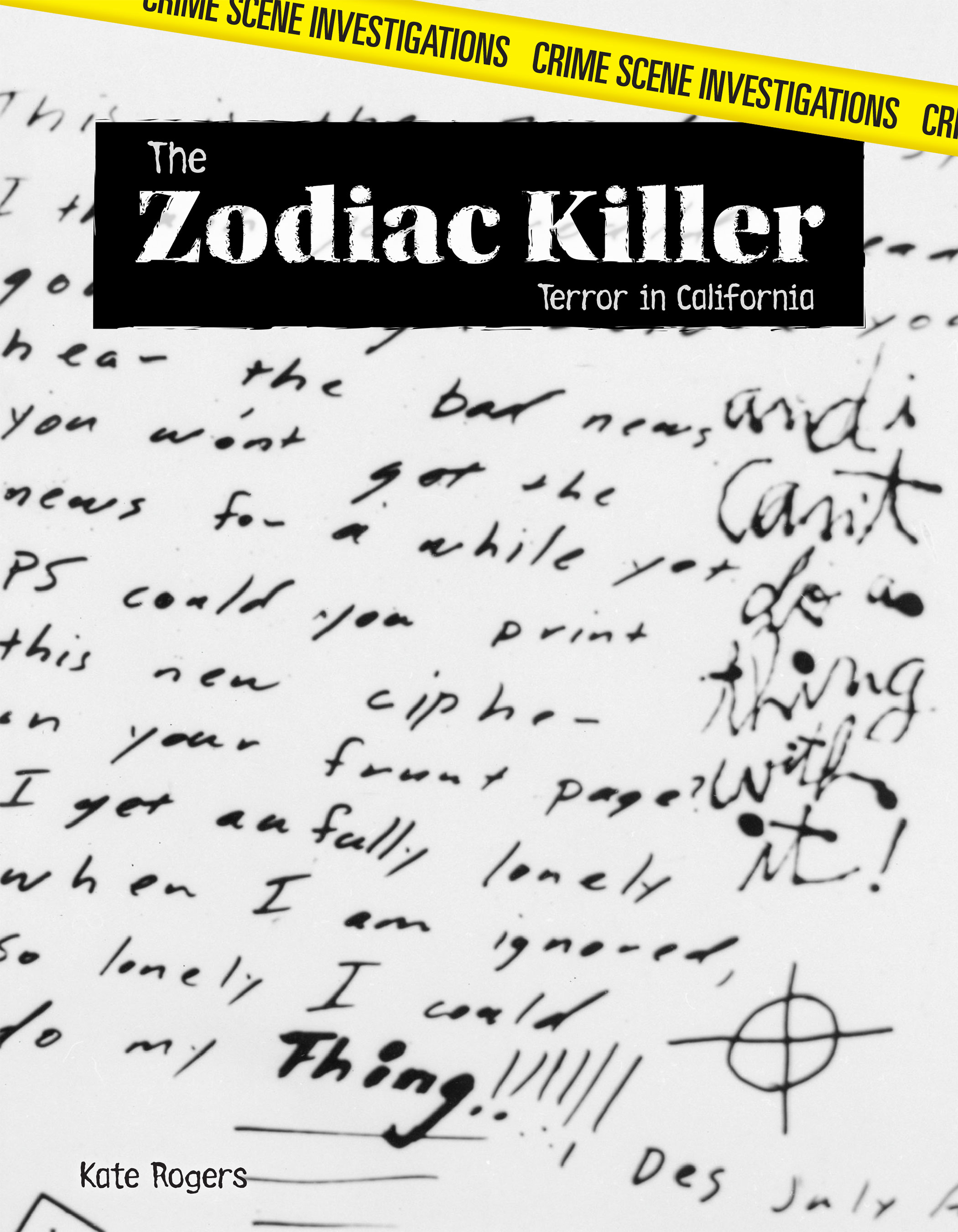- Introduction:
A Frightening Era - Chapter One:
Targeting Youth - Chapter Two:
Killer Communication - Chapter Three:
Zodiac Season - Chapter Four:
Suspicious Circumstances - Chapter Five:
An Unsolvable Case - Chapter Six:
A Cold Case Still Has Life
Published in 2018 by
Lucent Press, an Imprint of Greenhaven Publishing, LLC
353 3rd Avenue Suite 255
New York, NY 10010
Copyright 2018 Greenhaven Press, a part of Gale, Cengage Learning
Gale and Greenhaven Press are registered trademarks used herein under license.
All new materials copyright 2018 Lucent Press, an Imprint of Greenhaven Publishing, LLC.
All rights reserved. No part of this book may be reproduced in any form without permission in writing from the publisher, except by a reviewer.
Designer: Deanna Paternostro Editor: Siyavush Saidian
Cataloging-in-Publication Data
Names: Rogers, Kate.
Title: The Zodiac Killer: terror in California / Kate Rogers.
Description: New York : Lucent Press, 2018. | Series: Crime scene investigations | Includes index. Identifiers: ISBN 9781534560857 (library bound) | ISBN 9781534560864(ebook)
Subjects: LCSH: Serial murder investigation-California-Case studies-Juvenile literature. | Serial murders-California-Case studies-Juvenile literature.
Classification: LCC HV8079.H6 R64 2017 | DDC 364.152'30973--dc23
Printed in the United States of America
CPSIA compliance information: Batch #BS17KL: For further information contact Greenhaven Publishing LLC, New York, New York at 1-844-317-7404.
Please visit our website, www.greenhavenpublishing.com . For a free color catalog of all our high-quality books, call toll free 1-844-317-7404 or fax 1-844-317-7405.
Contents
Introduction:
A Frightening Era
Chapter One:
Targeting Youth
Chapter Two:
Killer Communication
Chapter Three:
Zodiac Season
Chapter Four:
Suspicious Circumstances
Chapter Five:
An Unsolvable Case
Chapter Six:
A Cold Case Still Has Life
Foreword
F or decades, popular television programs and movies have depicted the life and work of police officers, detectives, and crime scene investigators. Many of these shows and films portray forensic scientists as the brains responsible for cracking cases and bringing criminals to justice. Undoubtedly, these crime scene analysts are an important part in the process of crime solving. With modern technology and advances in forensic analysis, these highly trained experts are a crucial component of law enforcement systems all across the world.
Police officers and detectives are also integral members of the law enforcement team. They are the ones who respond to 911 calls about crime, collect physical evidence, and use their high level of training to identify suspects and culprits. They work right alongside forensic investigators to figure out the mysteries behind why a crime is committed, and the entire team cooperates to gather enough evidence to convict someone in a court of law.
Ever since the first laws were recorded, crime scene investigation has been handled in roughly the same way. An authority is informed that a crime has been committed; someone looks around the crime scene and interviews potential witnesses; suspects are identified based on evidence and testimony; and, finally, someone is formally accused of committing a crime. This basic plan is generally effective, and criminals are often caught and brought to justice. Throughout history, however, certain limitations have sometimes prevented authorities from finding out who was responsible for a crime.
There are many reasons why a crime goes unsolved: Maybe a dead body was found too late, evidence was tampered with, or witnesses lied. Sometimes, even the greatest technology of the age is simply not good enough to process and analyze the evidence at a crime scene. In the United States during the 20th century, for example, the person responsible for the infamous Zodiac killings was never found, despite the earnest efforts of hundreds of policemen, detectives, and forensic analysts.
In modern times, science and technology are integral to the investigative process. From DNA analysis to high-definition surveillance video, it has become much more difficult to commit a crime and get away with it. Using advanced computers and immense databases, microscopic skin cells from a crime scene can be collected and then analyzed by a forensic scientist, leading detectives to the home of the culprit of a crime. Dozens of people work behind the scenes of criminal investigations to figure out the unique and complex elements of a crime. Although this process is still time-consuming and complicated, technology is constantly improving and adapting to the needs of police forces worldwide.
This series is designed to help young readers understand the systems in place to allow forensic professionals to do their jobs. Covering a wide range of topics, from the assassination of President John F. Kennedy to 21st-century cybercriminals, these titles describe in detail the ways in which technology and criminal investigations have evolved over more than 50 years. They cite eyewitnesses and experts in order to give a detailed and nuanced picture of the difficult task of rooting out criminals. Although television shows and movies add drama to the crime scene investigation process, these real-life stories have enough drama on their own. This series sticks to the facts surrounding some of the highest-profile criminal cases of the modern era and the people who work to solve them and other crimes every day.

T he middle of the 20th century was a challenging time for the American people. President John F. Kennedy was assassinated in 1963, racial tensions were rising all across the nation, and the Vietnam War was still claiming thousands of lives overseas. With the rise of television, normal people were getting news from across the world like never before, and most of it was difficult to hear. San Francisco, California, was a city that was plagued by all of these issuesand more. American youths gathered there to protest the war in Vietnam, experiment with drugs, and try to make the world better with peaceful liberal politics. They were known as hippies, and they remain a controversial group to this day.

The neighborhood of Haight-Ashbury in San Francisco was at the heart of the hippie movement.
Alongside the peaceful hippie movement, some college students in San Francisco violently protested the war and the government. Moreover, a group of disgruntled African Americans, known as the Black Panther Party, was founded in nearby Oakland, California, in 1966. They aggressively campaigned for equal civil rights for black Americans and made the national news for marching into a meeting of the California state legislature while openly armed with rifles and shotguns. The group was not opposed to violent measures to achieve their goals; one of its founding members, Huey Newton, was arrested after engaging in a gun battle with police officers. The group did attempt to provide assistance to impoverished black people across the country, but today its members are most remembered for their reputation for violent activism.
Next page
